HBS109 - Analyzing Human Body Systems, Structure, Function & Diabetes
VerifiedAdded on 2023/06/11
|14
|3271
|336
Case Study
AI Summary
This case study delves into the intricate relationship between human body systems and diabetes, specifically focusing on the circulatory system, nephron (kidney system), and pancreas. It elaborates on the anatomy and physiology of these systems, highlighting their relevance to diabetes and the homeostatic mechanisms involved. The study further explores how blood circulation, blood glucose levels, and hormonal regulation are disrupted in diabetic patients, leading to complications such as hypertension and kidney disease. The case study also addresses the impact of diabetes on water re-absorption, nerve conduction, and urination frequency, explaining the underlying physiological processes and potential consequences. It provides a comprehensive overview of how diabetes affects multiple body systems and their integrated functions, offering valuable insights into the disease's complex pathophysiology. Desklib provides a platform to access similar case studies and solved assignments for students.

Running head: HUMAN BODY SYSTEMS AND THEIR STRUCTURE AND FUNCTION
Human body systems and their structure and function
Name of the student:
Name of the University:
Author note:
Human body systems and their structure and function
Name of the student:
Name of the University:
Author note:
Paraphrase This Document
Need a fresh take? Get an instant paraphrase of this document with our AI Paraphraser

1HUMAN BODY SYSTEMS AND THEIR STRUCTURE AND FUNCTION
Table of Contents
Part A:..............................................................................................................................................2
Anatomy and physiology of three relevant body systems:..........................................................2
Homeostatic mechanisms and integration of three body systems related to diabetes:................4
Part B:..............................................................................................................................................6
Question 1:...................................................................................................................................6
Question 2:...................................................................................................................................7
Question 3:...................................................................................................................................8
Question 4:...................................................................................................................................9
References:....................................................................................................................................10
Table of Contents
Part A:..............................................................................................................................................2
Anatomy and physiology of three relevant body systems:..........................................................2
Homeostatic mechanisms and integration of three body systems related to diabetes:................4
Part B:..............................................................................................................................................6
Question 1:...................................................................................................................................6
Question 2:...................................................................................................................................7
Question 3:...................................................................................................................................8
Question 4:...................................................................................................................................9
References:....................................................................................................................................10
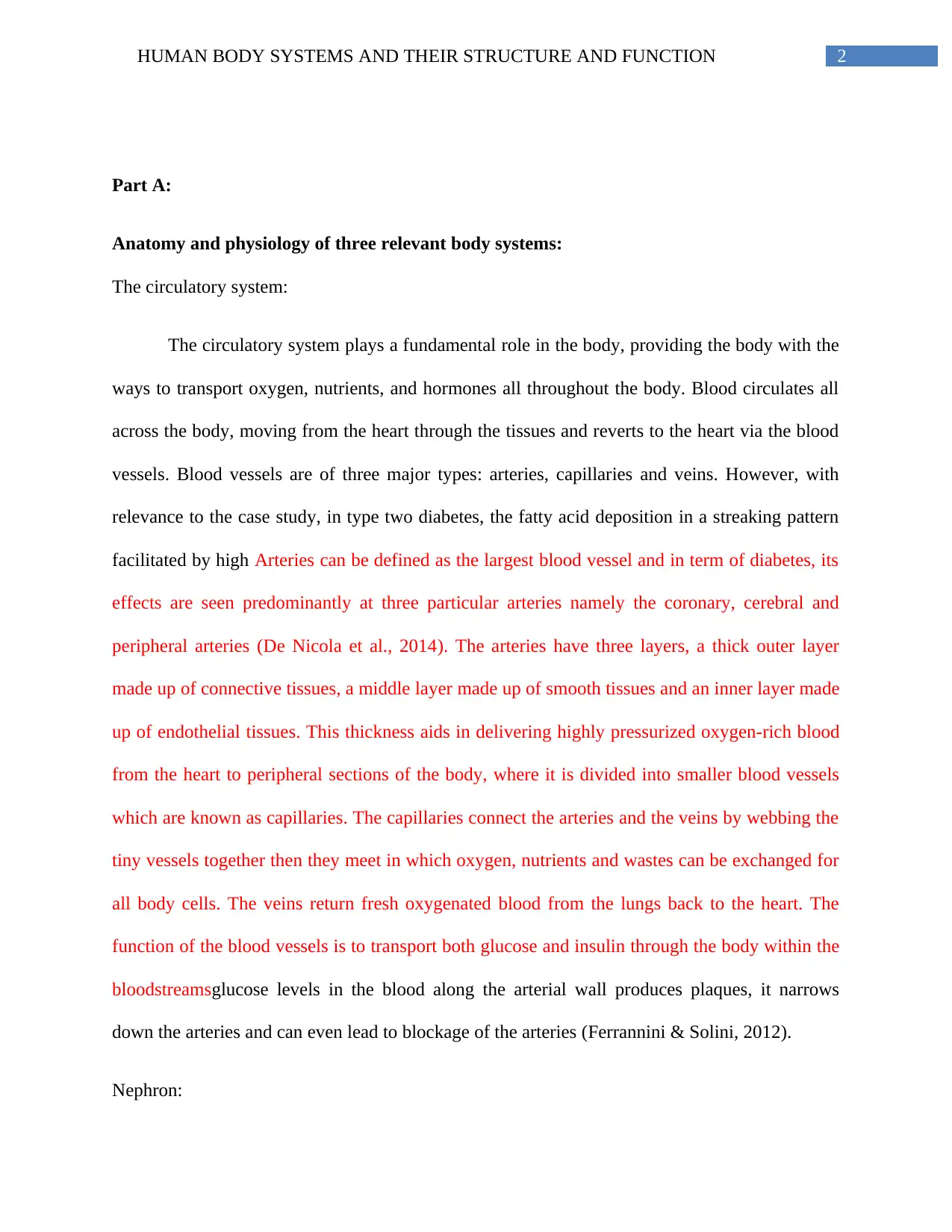
2HUMAN BODY SYSTEMS AND THEIR STRUCTURE AND FUNCTION
Part A:
Anatomy and physiology of three relevant body systems:
The circulatory system:
The circulatory system plays a fundamental role in the body, providing the body with the
ways to transport oxygen, nutrients, and hormones all throughout the body. Blood circulates all
across the body, moving from the heart through the tissues and reverts to the heart via the blood
vessels. Blood vessels are of three major types: arteries, capillaries and veins. However, with
relevance to the case study, in type two diabetes, the fatty acid deposition in a streaking pattern
facilitated by high Arteries can be defined as the largest blood vessel and in term of diabetes, its
effects are seen predominantly at three particular arteries namely the coronary, cerebral and
peripheral arteries (De Nicola et al., 2014). The arteries have three layers, a thick outer layer
made up of connective tissues, a middle layer made up of smooth tissues and an inner layer made
up of endothelial tissues. This thickness aids in delivering highly pressurized oxygen-rich blood
from the heart to peripheral sections of the body, where it is divided into smaller blood vessels
which are known as capillaries. The capillaries connect the arteries and the veins by webbing the
tiny vessels together then they meet in which oxygen, nutrients and wastes can be exchanged for
all body cells. The veins return fresh oxygenated blood from the lungs back to the heart. The
function of the blood vessels is to transport both glucose and insulin through the body within the
bloodstreamsglucose levels in the blood along the arterial wall produces plaques, it narrows
down the arteries and can even lead to blockage of the arteries (Ferrannini & Solini, 2012).
Nephron:
Part A:
Anatomy and physiology of three relevant body systems:
The circulatory system:
The circulatory system plays a fundamental role in the body, providing the body with the
ways to transport oxygen, nutrients, and hormones all throughout the body. Blood circulates all
across the body, moving from the heart through the tissues and reverts to the heart via the blood
vessels. Blood vessels are of three major types: arteries, capillaries and veins. However, with
relevance to the case study, in type two diabetes, the fatty acid deposition in a streaking pattern
facilitated by high Arteries can be defined as the largest blood vessel and in term of diabetes, its
effects are seen predominantly at three particular arteries namely the coronary, cerebral and
peripheral arteries (De Nicola et al., 2014). The arteries have three layers, a thick outer layer
made up of connective tissues, a middle layer made up of smooth tissues and an inner layer made
up of endothelial tissues. This thickness aids in delivering highly pressurized oxygen-rich blood
from the heart to peripheral sections of the body, where it is divided into smaller blood vessels
which are known as capillaries. The capillaries connect the arteries and the veins by webbing the
tiny vessels together then they meet in which oxygen, nutrients and wastes can be exchanged for
all body cells. The veins return fresh oxygenated blood from the lungs back to the heart. The
function of the blood vessels is to transport both glucose and insulin through the body within the
bloodstreamsglucose levels in the blood along the arterial wall produces plaques, it narrows
down the arteries and can even lead to blockage of the arteries (Ferrannini & Solini, 2012).
Nephron:
⊘ This is a preview!⊘
Do you want full access?
Subscribe today to unlock all pages.

Trusted by 1+ million students worldwide

3HUMAN BODY SYSTEMS AND THEIR STRUCTURE AND FUNCTION
The kidney system serves as the essential functional system in the body that purifies the
blood within the body and facilitates the excretion procedure of harmful toxic substances fromn
the body. The functional unit of this body system is the nephron that acts like a filter and
removes all toxic waste substances from the blood. The nephron is made up of a
glomerulus and renal tubular system. There is a capillary tuft inside the
glomerulus that receives blood from the afferent arteriole and releases into
the efferent arteriole. The glomerulus walls acts as the effective filtration
barrier, that under pressure helps in separating blood cells and large
molecules from the water and small molecules. The capillary barrier in
glomerulus essentially has an inner lining made up of and the outer layer of
the epithelial cells, the basement membrane, endothelial cells, the
mesangial or supporting tissue that encroaches on it in diabetic glomerular
disease (Inzucchi et al., 2015). The changes in the filtration barriers leads to
affecting the excretion of the renal protein leading to albuminuria. The
changes in the albumin molecules restrict the passage into ultra-filtrate due
to the intact glomerular wall. The glomerular ultra-filtrate is modified next by
the renal tubule system via the control of the water reabsorption happening
in the collecting ducts, distal convoluted tubule, the loop of Henle, proximal
convoluted tubule. In diabetes patients, the process of the diabetic
neuropathy leads to glomerulosclerosis changing the structural features of
the glomerulus facilitated by the increased extracellular deposition inside the
renal corpuscle which decreases the surface area available for filtration (Sulo
et al., 2013).
The kidney system serves as the essential functional system in the body that purifies the
blood within the body and facilitates the excretion procedure of harmful toxic substances fromn
the body. The functional unit of this body system is the nephron that acts like a filter and
removes all toxic waste substances from the blood. The nephron is made up of a
glomerulus and renal tubular system. There is a capillary tuft inside the
glomerulus that receives blood from the afferent arteriole and releases into
the efferent arteriole. The glomerulus walls acts as the effective filtration
barrier, that under pressure helps in separating blood cells and large
molecules from the water and small molecules. The capillary barrier in
glomerulus essentially has an inner lining made up of and the outer layer of
the epithelial cells, the basement membrane, endothelial cells, the
mesangial or supporting tissue that encroaches on it in diabetic glomerular
disease (Inzucchi et al., 2015). The changes in the filtration barriers leads to
affecting the excretion of the renal protein leading to albuminuria. The
changes in the albumin molecules restrict the passage into ultra-filtrate due
to the intact glomerular wall. The glomerular ultra-filtrate is modified next by
the renal tubule system via the control of the water reabsorption happening
in the collecting ducts, distal convoluted tubule, the loop of Henle, proximal
convoluted tubule. In diabetes patients, the process of the diabetic
neuropathy leads to glomerulosclerosis changing the structural features of
the glomerulus facilitated by the increased extracellular deposition inside the
renal corpuscle which decreases the surface area available for filtration (Sulo
et al., 2013).
Paraphrase This Document
Need a fresh take? Get an instant paraphrase of this document with our AI Paraphraser
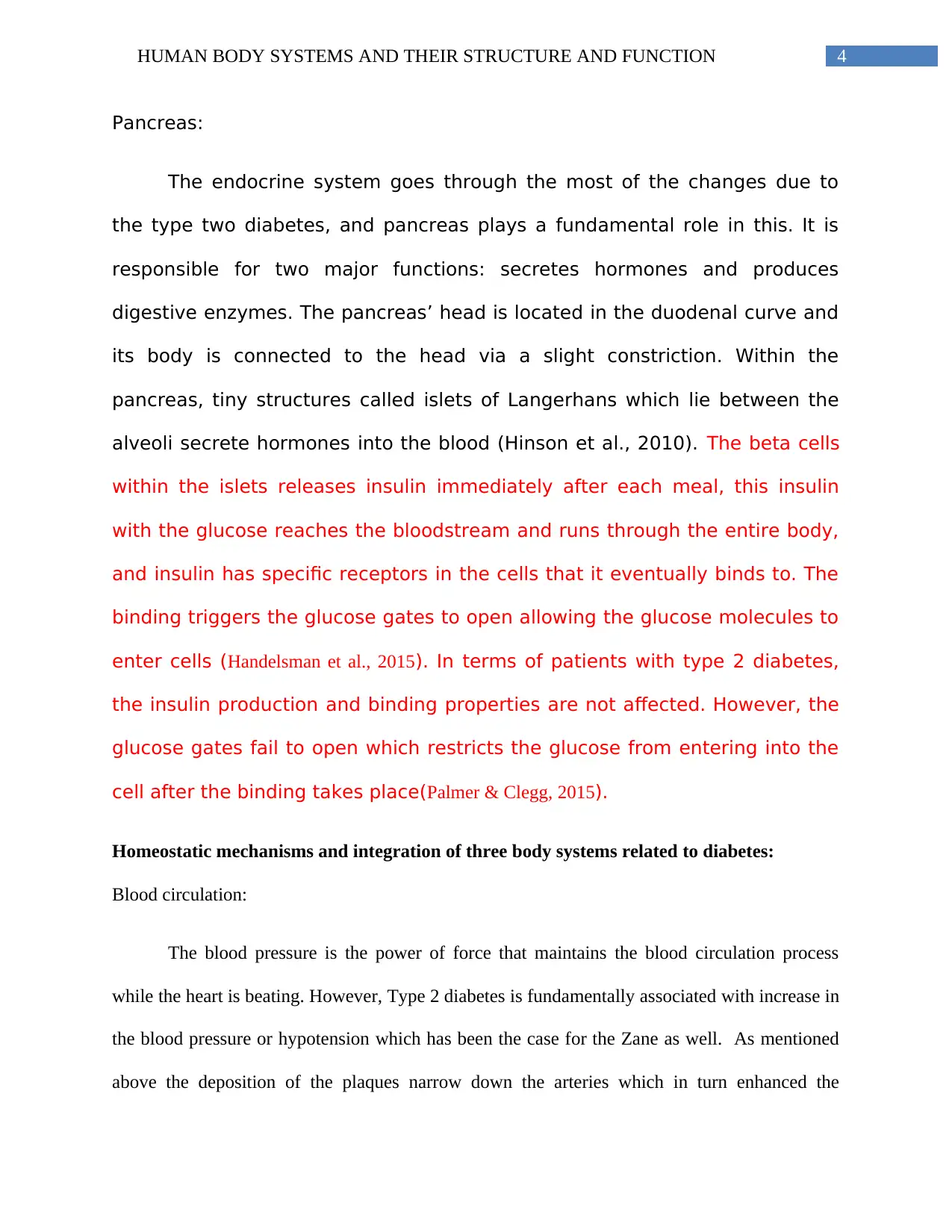
4HUMAN BODY SYSTEMS AND THEIR STRUCTURE AND FUNCTION
Pancreas:
The endocrine system goes through the most of the changes due to
the type two diabetes, and pancreas plays a fundamental role in this. It is
responsible for two major functions: secretes hormones and produces
digestive enzymes. The pancreas’ head is located in the duodenal curve and
its body is connected to the head via a slight constriction. Within the
pancreas, tiny structures called islets of Langerhans which lie between the
alveoli secrete hormones into the blood (Hinson et al., 2010). The beta cells
within the islets releases insulin immediately after each meal, this insulin
with the glucose reaches the bloodstream and runs through the entire body,
and insulin has specific receptors in the cells that it eventually binds to. The
binding triggers the glucose gates to open allowing the glucose molecules to
enter cells (Handelsman et al., 2015). In terms of patients with type 2 diabetes,
the insulin production and binding properties are not affected. However, the
glucose gates fail to open which restricts the glucose from entering into the
cell after the binding takes place(Palmer & Clegg, 2015).
Homeostatic mechanisms and integration of three body systems related to diabetes:
Blood circulation:
The blood pressure is the power of force that maintains the blood circulation process
while the heart is beating. However, Type 2 diabetes is fundamentally associated with increase in
the blood pressure or hypotension which has been the case for the Zane as well. As mentioned
above the deposition of the plaques narrow down the arteries which in turn enhanced the
Pancreas:
The endocrine system goes through the most of the changes due to
the type two diabetes, and pancreas plays a fundamental role in this. It is
responsible for two major functions: secretes hormones and produces
digestive enzymes. The pancreas’ head is located in the duodenal curve and
its body is connected to the head via a slight constriction. Within the
pancreas, tiny structures called islets of Langerhans which lie between the
alveoli secrete hormones into the blood (Hinson et al., 2010). The beta cells
within the islets releases insulin immediately after each meal, this insulin
with the glucose reaches the bloodstream and runs through the entire body,
and insulin has specific receptors in the cells that it eventually binds to. The
binding triggers the glucose gates to open allowing the glucose molecules to
enter cells (Handelsman et al., 2015). In terms of patients with type 2 diabetes,
the insulin production and binding properties are not affected. However, the
glucose gates fail to open which restricts the glucose from entering into the
cell after the binding takes place(Palmer & Clegg, 2015).
Homeostatic mechanisms and integration of three body systems related to diabetes:
Blood circulation:
The blood pressure is the power of force that maintains the blood circulation process
while the heart is beating. However, Type 2 diabetes is fundamentally associated with increase in
the blood pressure or hypotension which has been the case for the Zane as well. As mentioned
above the deposition of the plaques narrow down the arteries which in turn enhanced the
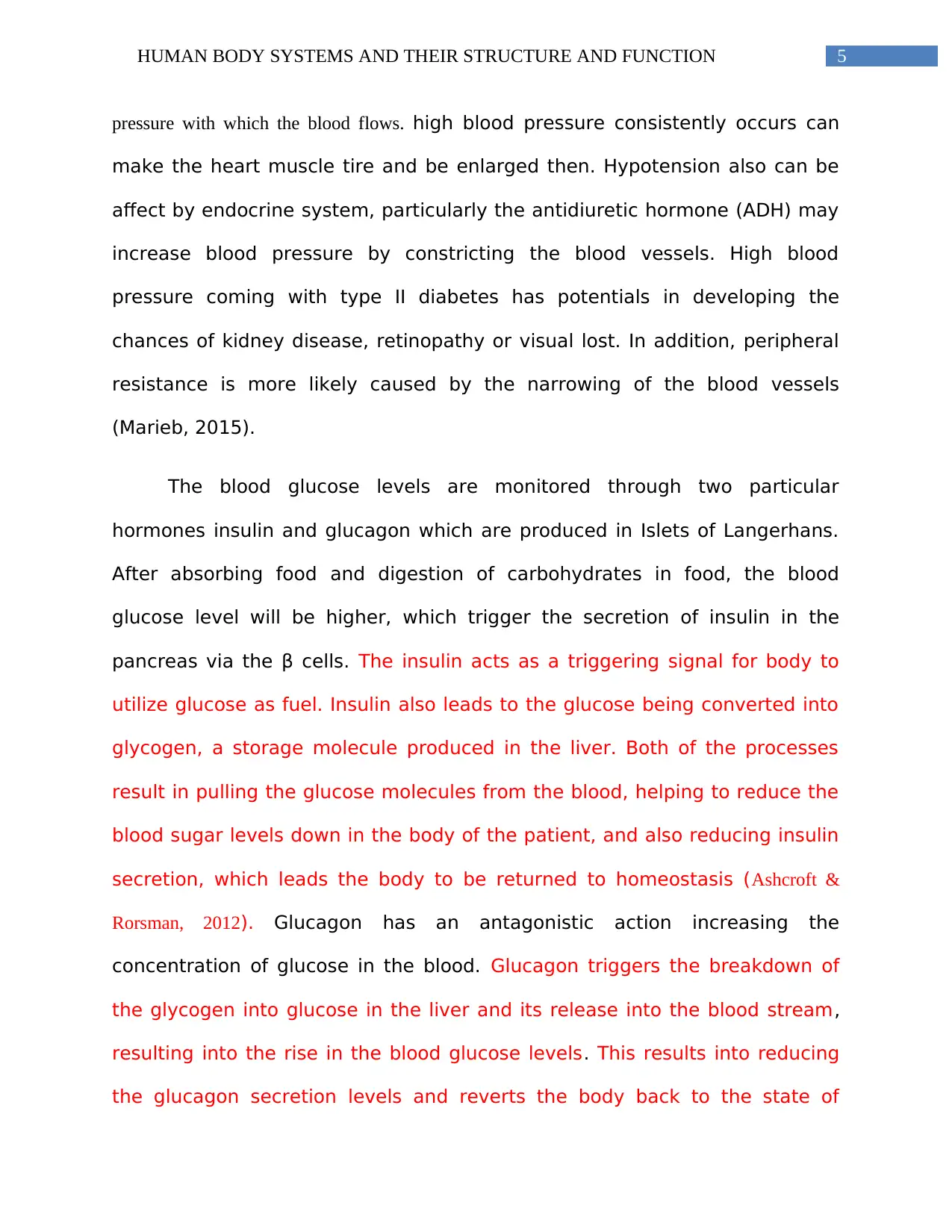
5HUMAN BODY SYSTEMS AND THEIR STRUCTURE AND FUNCTION
pressure with which the blood flows. high blood pressure consistently occurs can
make the heart muscle tire and be enlarged then. Hypotension also can be
affect by endocrine system, particularly the antidiuretic hormone (ADH) may
increase blood pressure by constricting the blood vessels. High blood
pressure coming with type II diabetes has potentials in developing the
chances of kidney disease, retinopathy or visual lost. In addition, peripheral
resistance is more likely caused by the narrowing of the blood vessels
(Marieb, 2015).
The blood glucose levels are monitored through two particular
hormones insulin and glucagon which are produced in Islets of Langerhans.
After absorbing food and digestion of carbohydrates in food, the blood
glucose level will be higher, which trigger the secretion of insulin in the
pancreas via the β cells. The insulin acts as a triggering signal for body to
utilize glucose as fuel. Insulin also leads to the glucose being converted into
glycogen, a storage molecule produced in the liver. Both of the processes
result in pulling the glucose molecules from the blood, helping to reduce the
blood sugar levels down in the body of the patient, and also reducing insulin
secretion, which leads the body to be returned to homeostasis (Ashcroft &
Rorsman, 2012). Glucagon has an antagonistic action increasing the
concentration of glucose in the blood. Glucagon triggers the breakdown of
the glycogen into glucose in the liver and its release into the blood stream,
resulting into the rise in the blood glucose levels. This results into reducing
the glucagon secretion levels and reverts the body back to the state of
pressure with which the blood flows. high blood pressure consistently occurs can
make the heart muscle tire and be enlarged then. Hypotension also can be
affect by endocrine system, particularly the antidiuretic hormone (ADH) may
increase blood pressure by constricting the blood vessels. High blood
pressure coming with type II diabetes has potentials in developing the
chances of kidney disease, retinopathy or visual lost. In addition, peripheral
resistance is more likely caused by the narrowing of the blood vessels
(Marieb, 2015).
The blood glucose levels are monitored through two particular
hormones insulin and glucagon which are produced in Islets of Langerhans.
After absorbing food and digestion of carbohydrates in food, the blood
glucose level will be higher, which trigger the secretion of insulin in the
pancreas via the β cells. The insulin acts as a triggering signal for body to
utilize glucose as fuel. Insulin also leads to the glucose being converted into
glycogen, a storage molecule produced in the liver. Both of the processes
result in pulling the glucose molecules from the blood, helping to reduce the
blood sugar levels down in the body of the patient, and also reducing insulin
secretion, which leads the body to be returned to homeostasis (Ashcroft &
Rorsman, 2012). Glucagon has an antagonistic action increasing the
concentration of glucose in the blood. Glucagon triggers the breakdown of
the glycogen into glucose in the liver and its release into the blood stream,
resulting into the rise in the blood glucose levels. This results into reducing
the glucagon secretion levels and reverts the body back to the state of
⊘ This is a preview!⊘
Do you want full access?
Subscribe today to unlock all pages.

Trusted by 1+ million students worldwide
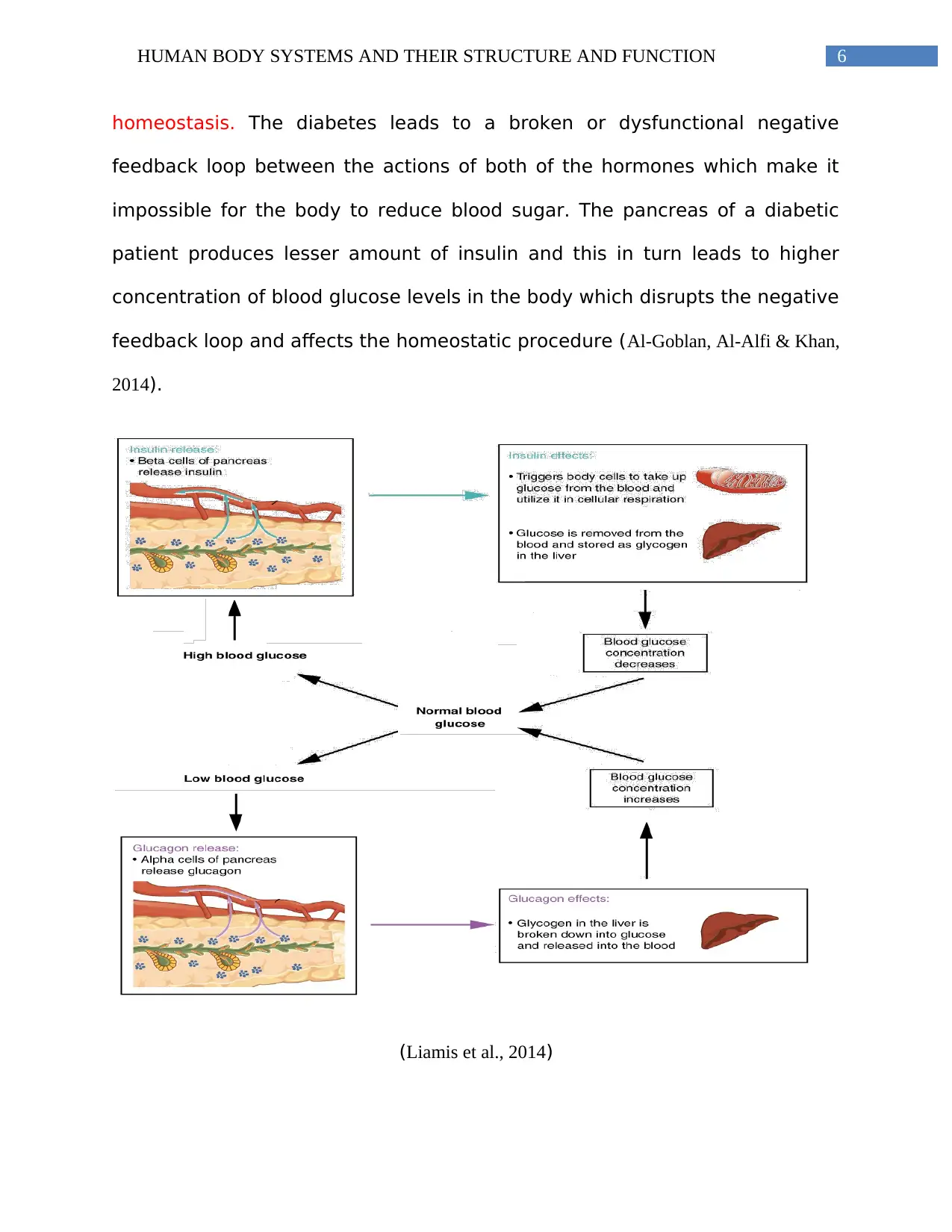
6HUMAN BODY SYSTEMS AND THEIR STRUCTURE AND FUNCTION
homeostasis. The diabetes leads to a broken or dysfunctional negative
feedback loop between the actions of both of the hormones which make it
impossible for the body to reduce blood sugar. The pancreas of a diabetic
patient produces lesser amount of insulin and this in turn leads to higher
concentration of blood glucose levels in the body which disrupts the negative
feedback loop and affects the homeostatic procedure (Al-Goblan, Al-Alfi & Khan,
2014).
(Liamis et al., 2014)
homeostasis. The diabetes leads to a broken or dysfunctional negative
feedback loop between the actions of both of the hormones which make it
impossible for the body to reduce blood sugar. The pancreas of a diabetic
patient produces lesser amount of insulin and this in turn leads to higher
concentration of blood glucose levels in the body which disrupts the negative
feedback loop and affects the homeostatic procedure (Al-Goblan, Al-Alfi & Khan,
2014).
(Liamis et al., 2014)
Paraphrase This Document
Need a fresh take? Get an instant paraphrase of this document with our AI Paraphraser

7HUMAN BODY SYSTEMS AND THEIR STRUCTURE AND FUNCTION
Part B:
Question 1:
The balance between water re-absorption and excretion is maintained by the series of
negative feedback loop with the help of endocrine system and the autonomic nervous system.
During the decrease in the fluid volume, there is an increase in the concentration of sodium in the
blood due to the increased osmolarity, which leads to the stimulation of the hypothalamus. The
hypothalamus acts as an osmoreceptor, which has been reported to react to changes in osmotic
pressure and in turn has a significant impact on the pituitary gland. In response, the posterior
pituitary gland releases antidiuretic hormone or vasopressin into the bloodstream and the
hormone facilitates water retention by the kidneys. as a result there is an increase in
concentration of the urine and an increase in the amount of water that returns to the ECF, thus as
a result the volume depletion is corrected (Hinson, Raven & Chew, 2010). with the
decreased sodium concentration in the blood, the adrenal cortex is
stimulated which then secretes aldosterone. The aldosterone instructs the
distal nephrons of the kidney into retaining higher concentration of sodium.
In case of diabetes, the increased glucose concentration leads to
hyponatremia facilitated by affecting the serum electrolyte balance or
homeostasis. The rise in the glucose concentration leads to a marked
increase in the osmotic force that draws the water to the extracellular space.
This phenomenon dilutes the extracellular sodium and causes a decrease in
the plasma sodium concentration. However the external insulin and
sulfonylureas are also known to cause hyponatremia by augmenting the
effects of vasopressin at the renal collecting ducts. Another signature change
Part B:
Question 1:
The balance between water re-absorption and excretion is maintained by the series of
negative feedback loop with the help of endocrine system and the autonomic nervous system.
During the decrease in the fluid volume, there is an increase in the concentration of sodium in the
blood due to the increased osmolarity, which leads to the stimulation of the hypothalamus. The
hypothalamus acts as an osmoreceptor, which has been reported to react to changes in osmotic
pressure and in turn has a significant impact on the pituitary gland. In response, the posterior
pituitary gland releases antidiuretic hormone or vasopressin into the bloodstream and the
hormone facilitates water retention by the kidneys. as a result there is an increase in
concentration of the urine and an increase in the amount of water that returns to the ECF, thus as
a result the volume depletion is corrected (Hinson, Raven & Chew, 2010). with the
decreased sodium concentration in the blood, the adrenal cortex is
stimulated which then secretes aldosterone. The aldosterone instructs the
distal nephrons of the kidney into retaining higher concentration of sodium.
In case of diabetes, the increased glucose concentration leads to
hyponatremia facilitated by affecting the serum electrolyte balance or
homeostasis. The rise in the glucose concentration leads to a marked
increase in the osmotic force that draws the water to the extracellular space.
This phenomenon dilutes the extracellular sodium and causes a decrease in
the plasma sodium concentration. However the external insulin and
sulfonylureas are also known to cause hyponatremia by augmenting the
effects of vasopressin at the renal collecting ducts. Another signature change
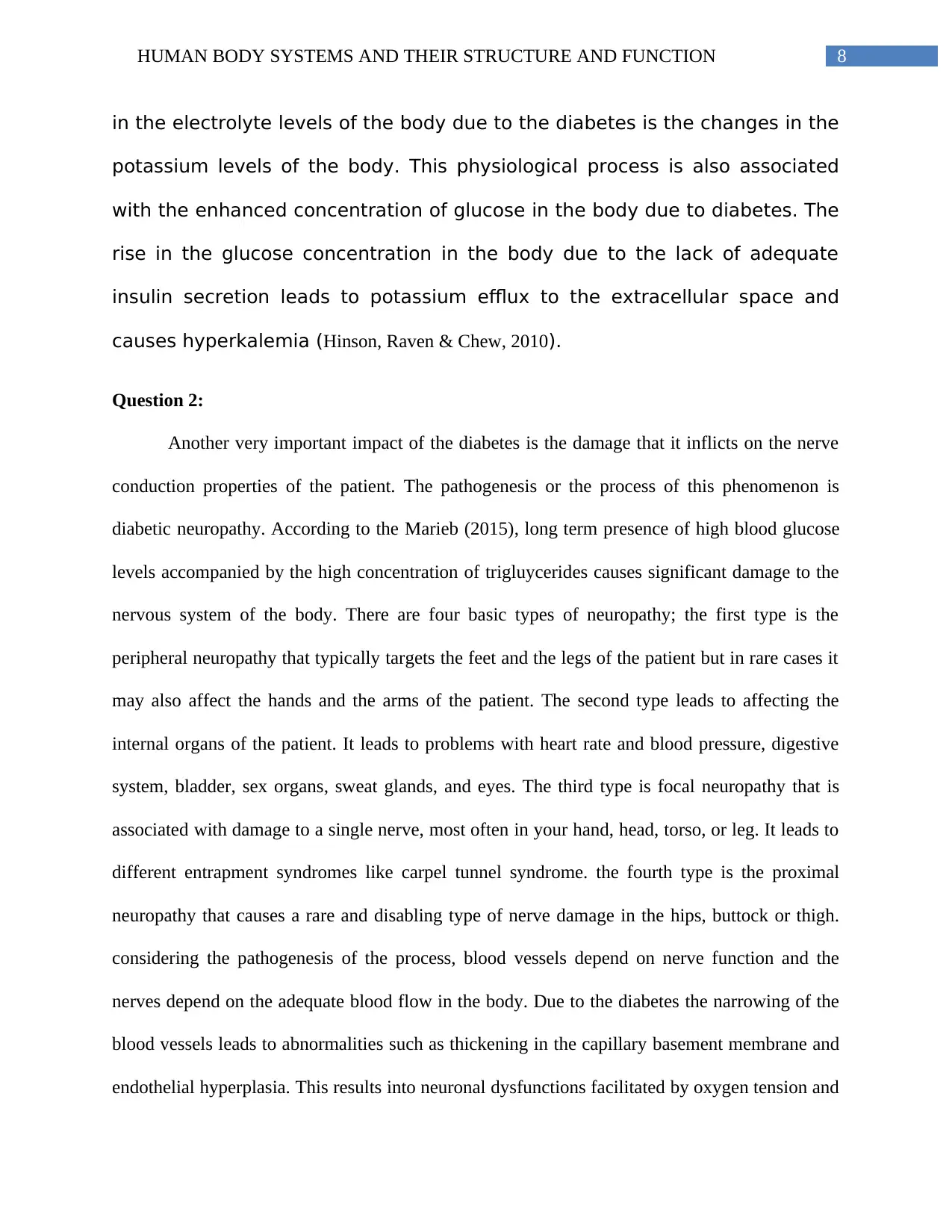
8HUMAN BODY SYSTEMS AND THEIR STRUCTURE AND FUNCTION
in the electrolyte levels of the body due to the diabetes is the changes in the
potassium levels of the body. This physiological process is also associated
with the enhanced concentration of glucose in the body due to diabetes. The
rise in the glucose concentration in the body due to the lack of adequate
insulin secretion leads to potassium efflux to the extracellular space and
causes hyperkalemia (Hinson, Raven & Chew, 2010).
Question 2:
Another very important impact of the diabetes is the damage that it inflicts on the nerve
conduction properties of the patient. The pathogenesis or the process of this phenomenon is
diabetic neuropathy. According to the Marieb (2015), long term presence of high blood glucose
levels accompanied by the high concentration of trigluycerides causes significant damage to the
nervous system of the body. There are four basic types of neuropathy; the first type is the
peripheral neuropathy that typically targets the feet and the legs of the patient but in rare cases it
may also affect the hands and the arms of the patient. The second type leads to affecting the
internal organs of the patient. It leads to problems with heart rate and blood pressure, digestive
system, bladder, sex organs, sweat glands, and eyes. The third type is focal neuropathy that is
associated with damage to a single nerve, most often in your hand, head, torso, or leg. It leads to
different entrapment syndromes like carpel tunnel syndrome. the fourth type is the proximal
neuropathy that causes a rare and disabling type of nerve damage in the hips, buttock or thigh.
considering the pathogenesis of the process, blood vessels depend on nerve function and the
nerves depend on the adequate blood flow in the body. Due to the diabetes the narrowing of the
blood vessels leads to abnormalities such as thickening in the capillary basement membrane and
endothelial hyperplasia. This results into neuronal dysfunctions facilitated by oxygen tension and
in the electrolyte levels of the body due to the diabetes is the changes in the
potassium levels of the body. This physiological process is also associated
with the enhanced concentration of glucose in the body due to diabetes. The
rise in the glucose concentration in the body due to the lack of adequate
insulin secretion leads to potassium efflux to the extracellular space and
causes hyperkalemia (Hinson, Raven & Chew, 2010).
Question 2:
Another very important impact of the diabetes is the damage that it inflicts on the nerve
conduction properties of the patient. The pathogenesis or the process of this phenomenon is
diabetic neuropathy. According to the Marieb (2015), long term presence of high blood glucose
levels accompanied by the high concentration of trigluycerides causes significant damage to the
nervous system of the body. There are four basic types of neuropathy; the first type is the
peripheral neuropathy that typically targets the feet and the legs of the patient but in rare cases it
may also affect the hands and the arms of the patient. The second type leads to affecting the
internal organs of the patient. It leads to problems with heart rate and blood pressure, digestive
system, bladder, sex organs, sweat glands, and eyes. The third type is focal neuropathy that is
associated with damage to a single nerve, most often in your hand, head, torso, or leg. It leads to
different entrapment syndromes like carpel tunnel syndrome. the fourth type is the proximal
neuropathy that causes a rare and disabling type of nerve damage in the hips, buttock or thigh.
considering the pathogenesis of the process, blood vessels depend on nerve function and the
nerves depend on the adequate blood flow in the body. Due to the diabetes the narrowing of the
blood vessels leads to abnormalities such as thickening in the capillary basement membrane and
endothelial hyperplasia. This results into neuronal dysfunctions facilitated by oxygen tension and
⊘ This is a preview!⊘
Do you want full access?
Subscribe today to unlock all pages.

Trusted by 1+ million students worldwide
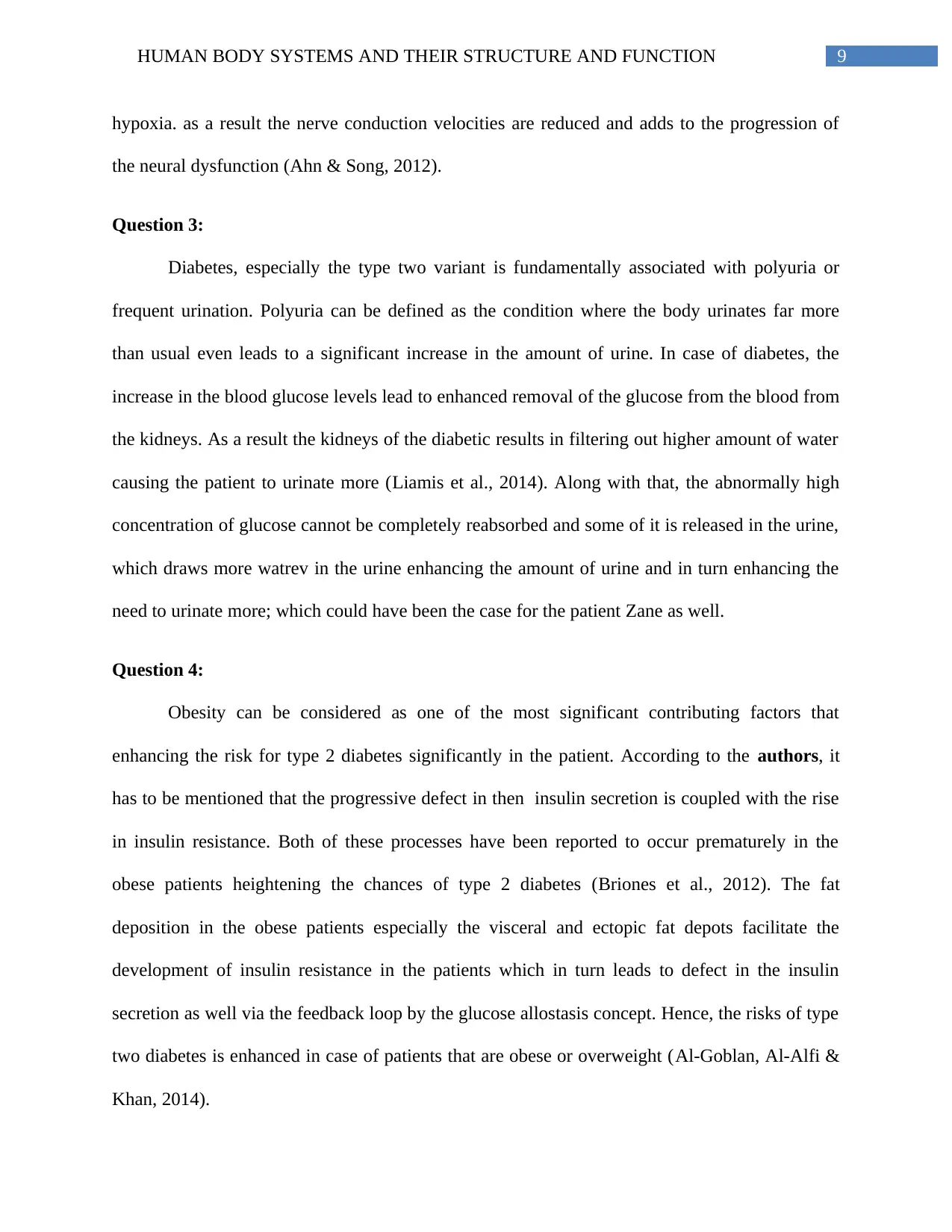
9HUMAN BODY SYSTEMS AND THEIR STRUCTURE AND FUNCTION
hypoxia. as a result the nerve conduction velocities are reduced and adds to the progression of
the neural dysfunction (Ahn & Song, 2012).
Question 3:
Diabetes, especially the type two variant is fundamentally associated with polyuria or
frequent urination. Polyuria can be defined as the condition where the body urinates far more
than usual even leads to a significant increase in the amount of urine. In case of diabetes, the
increase in the blood glucose levels lead to enhanced removal of the glucose from the blood from
the kidneys. As a result the kidneys of the diabetic results in filtering out higher amount of water
causing the patient to urinate more (Liamis et al., 2014). Along with that, the abnormally high
concentration of glucose cannot be completely reabsorbed and some of it is released in the urine,
which draws more watrev in the urine enhancing the amount of urine and in turn enhancing the
need to urinate more; which could have been the case for the patient Zane as well.
Question 4:
Obesity can be considered as one of the most significant contributing factors that
enhancing the risk for type 2 diabetes significantly in the patient. According to the authors, it
has to be mentioned that the progressive defect in then insulin secretion is coupled with the rise
in insulin resistance. Both of these processes have been reported to occur prematurely in the
obese patients heightening the chances of type 2 diabetes (Briones et al., 2012). The fat
deposition in the obese patients especially the visceral and ectopic fat depots facilitate the
development of insulin resistance in the patients which in turn leads to defect in the insulin
secretion as well via the feedback loop by the glucose allostasis concept. Hence, the risks of type
two diabetes is enhanced in case of patients that are obese or overweight (Al-Goblan, Al-Alfi &
Khan, 2014).
hypoxia. as a result the nerve conduction velocities are reduced and adds to the progression of
the neural dysfunction (Ahn & Song, 2012).
Question 3:
Diabetes, especially the type two variant is fundamentally associated with polyuria or
frequent urination. Polyuria can be defined as the condition where the body urinates far more
than usual even leads to a significant increase in the amount of urine. In case of diabetes, the
increase in the blood glucose levels lead to enhanced removal of the glucose from the blood from
the kidneys. As a result the kidneys of the diabetic results in filtering out higher amount of water
causing the patient to urinate more (Liamis et al., 2014). Along with that, the abnormally high
concentration of glucose cannot be completely reabsorbed and some of it is released in the urine,
which draws more watrev in the urine enhancing the amount of urine and in turn enhancing the
need to urinate more; which could have been the case for the patient Zane as well.
Question 4:
Obesity can be considered as one of the most significant contributing factors that
enhancing the risk for type 2 diabetes significantly in the patient. According to the authors, it
has to be mentioned that the progressive defect in then insulin secretion is coupled with the rise
in insulin resistance. Both of these processes have been reported to occur prematurely in the
obese patients heightening the chances of type 2 diabetes (Briones et al., 2012). The fat
deposition in the obese patients especially the visceral and ectopic fat depots facilitate the
development of insulin resistance in the patients which in turn leads to defect in the insulin
secretion as well via the feedback loop by the glucose allostasis concept. Hence, the risks of type
two diabetes is enhanced in case of patients that are obese or overweight (Al-Goblan, Al-Alfi &
Khan, 2014).
Paraphrase This Document
Need a fresh take? Get an instant paraphrase of this document with our AI Paraphraser

10HUMAN BODY SYSTEMS AND THEIR STRUCTURE AND FUNCTION
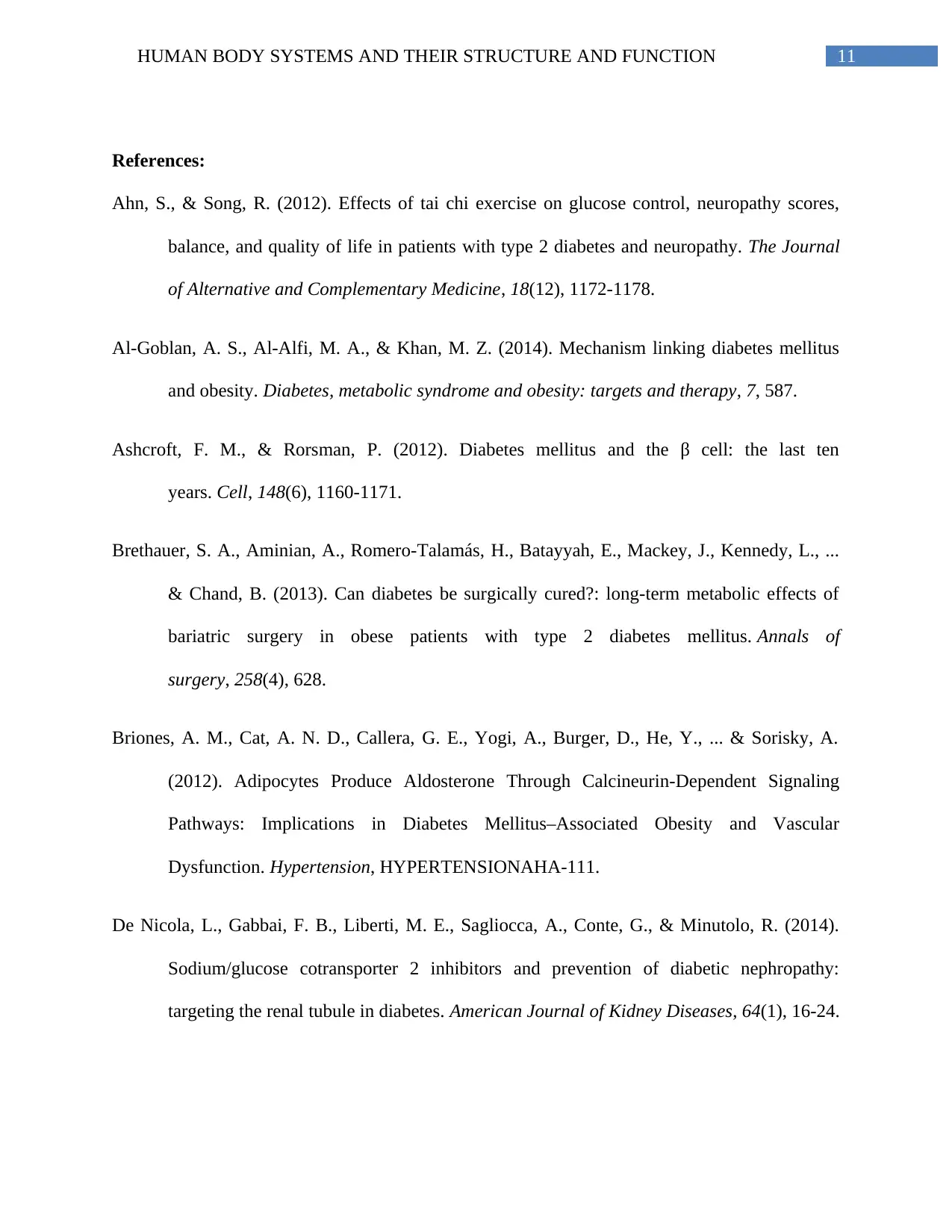
11HUMAN BODY SYSTEMS AND THEIR STRUCTURE AND FUNCTION
References:
Ahn, S., & Song, R. (2012). Effects of tai chi exercise on glucose control, neuropathy scores,
balance, and quality of life in patients with type 2 diabetes and neuropathy. The Journal
of Alternative and Complementary Medicine, 18(12), 1172-1178.
Al-Goblan, A. S., Al-Alfi, M. A., & Khan, M. Z. (2014). Mechanism linking diabetes mellitus
and obesity. Diabetes, metabolic syndrome and obesity: targets and therapy, 7, 587.
Ashcroft, F. M., & Rorsman, P. (2012). Diabetes mellitus and the β cell: the last ten
years. Cell, 148(6), 1160-1171.
Brethauer, S. A., Aminian, A., Romero-Talamás, H., Batayyah, E., Mackey, J., Kennedy, L., ...
& Chand, B. (2013). Can diabetes be surgically cured?: long-term metabolic effects of
bariatric surgery in obese patients with type 2 diabetes mellitus. Annals of
surgery, 258(4), 628.
Briones, A. M., Cat, A. N. D., Callera, G. E., Yogi, A., Burger, D., He, Y., ... & Sorisky, A.
(2012). Adipocytes Produce Aldosterone Through Calcineurin-Dependent Signaling
Pathways: Implications in Diabetes Mellitus–Associated Obesity and Vascular
Dysfunction. Hypertension, HYPERTENSIONAHA-111.
De Nicola, L., Gabbai, F. B., Liberti, M. E., Sagliocca, A., Conte, G., & Minutolo, R. (2014).
Sodium/glucose cotransporter 2 inhibitors and prevention of diabetic nephropathy:
targeting the renal tubule in diabetes. American Journal of Kidney Diseases, 64(1), 16-24.
References:
Ahn, S., & Song, R. (2012). Effects of tai chi exercise on glucose control, neuropathy scores,
balance, and quality of life in patients with type 2 diabetes and neuropathy. The Journal
of Alternative and Complementary Medicine, 18(12), 1172-1178.
Al-Goblan, A. S., Al-Alfi, M. A., & Khan, M. Z. (2014). Mechanism linking diabetes mellitus
and obesity. Diabetes, metabolic syndrome and obesity: targets and therapy, 7, 587.
Ashcroft, F. M., & Rorsman, P. (2012). Diabetes mellitus and the β cell: the last ten
years. Cell, 148(6), 1160-1171.
Brethauer, S. A., Aminian, A., Romero-Talamás, H., Batayyah, E., Mackey, J., Kennedy, L., ...
& Chand, B. (2013). Can diabetes be surgically cured?: long-term metabolic effects of
bariatric surgery in obese patients with type 2 diabetes mellitus. Annals of
surgery, 258(4), 628.
Briones, A. M., Cat, A. N. D., Callera, G. E., Yogi, A., Burger, D., He, Y., ... & Sorisky, A.
(2012). Adipocytes Produce Aldosterone Through Calcineurin-Dependent Signaling
Pathways: Implications in Diabetes Mellitus–Associated Obesity and Vascular
Dysfunction. Hypertension, HYPERTENSIONAHA-111.
De Nicola, L., Gabbai, F. B., Liberti, M. E., Sagliocca, A., Conte, G., & Minutolo, R. (2014).
Sodium/glucose cotransporter 2 inhibitors and prevention of diabetic nephropathy:
targeting the renal tubule in diabetes. American Journal of Kidney Diseases, 64(1), 16-24.
⊘ This is a preview!⊘
Do you want full access?
Subscribe today to unlock all pages.

Trusted by 1+ million students worldwide
1 out of 14
Related Documents
Your All-in-One AI-Powered Toolkit for Academic Success.
+13062052269
info@desklib.com
Available 24*7 on WhatsApp / Email
![[object Object]](/_next/static/media/star-bottom.7253800d.svg)
Unlock your academic potential
Copyright © 2020–2025 A2Z Services. All Rights Reserved. Developed and managed by ZUCOL.





